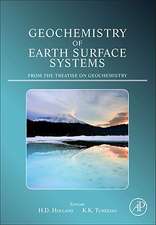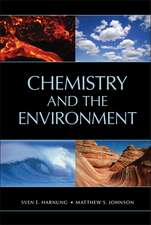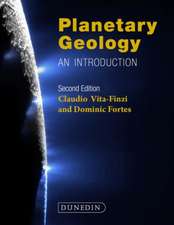The Hagendorf-Pleystein Province: the Center of Pegmatites in an Ensialic Orogen: Modern Approaches in Solid Earth Sciences, cartea 15
Autor Harald G. Dillen Limba Engleză Hardback – 28 oct 2015
The Late Paleozoic rare-element pegmatites of the HPPP, Oberpfalz-SE, Germany, rank among the largest concentrations in Europe. The biggest pegmatite of this mining district totals 4.4 million tons of ore (Hagendorf-South). The mining history of the HPPP is restricted to the 20th century, when local entrepreneurs started mining operations in search of ceramic raw materials, feldspar and quartz. Today the “Silbergrube Aplite” is still worked for feldspar. The traditional mining of pegmatitic and aplitic rocks in Central Europe, such as the Bohemian Massif, which is shared by Germany, the Czech Republic, Poland and Austria, has been focused on these industrial minerals. In addition to these major commodities, lithium was mined for a period of time. But even today many of these pegmatites of calc-alkaline affiliation have not lost their appeal to mineralogists and mineral enthusiasts for their wealth of minerals that contain P, Nb, Ta, Li, Be, B, U, Th, Sc, Ti and Sn. The most favorable crustal section to bring about pegmatitic rocks of this type, encompassing pegmatoids, metapegmatites, reactivated pseudopegmatites and pegmatites sensu stricto is the ensialic orogen,
exemplified by the Variscan (Hercynian) Orogen, which geodynamically connects the Paleozoic pegmatite provinces in North America and Europe. The geological history of the HPPP, however, goes much further than the Carboniferous-Permian magmatic activity, when the last structural disturbances of the Variscan orogeny affected the NE-Bavarian Basement between 450 and 330 Ma. During this time mafic magmatic rocks together with calcareous and arenaceous sediments were converted into paragneisses, calcsilicate rocks, and amphibolites. It is the period of time when tectonic shortening led to over thrusting and when the emplacement of nappes and the architectural elements of the ensialic orogen began taking shape. During the Late Permian, the Mesozoic and the Cenozoic, the HPPP did not lie idle in geological terms; hypogene and supergene alteration continued and found its most recent expression in alluvial-fluvial “nigrine” placer deposits, which resulted from the unroofing of the pegmatites and aplites in the HPPP and can be used even outside HPPP as an ore guide to pegmatites.
| Toate formatele și edițiile | Preț | Express |
|---|---|---|
| Paperback (1) | 649.87 lei 6-8 săpt. | |
| Springer International Publishing – 23 aug 2016 | 649.87 lei 6-8 săpt. | |
| Hardback (1) | 602.78 lei 38-44 zile | |
| Springer International Publishing – 28 oct 2015 | 602.78 lei 38-44 zile |
Din seria Modern Approaches in Solid Earth Sciences
- 15%
 Preț: 646.75 lei
Preț: 646.75 lei -
 Preț: 424.33 lei
Preț: 424.33 lei - 17%
 Preț: 492.95 lei
Preț: 492.95 lei - 18%
 Preț: 958.56 lei
Preț: 958.56 lei - 15%
 Preț: 673.60 lei
Preț: 673.60 lei - 15%
 Preț: 651.19 lei
Preț: 651.19 lei - 23%
 Preț: 1075.96 lei
Preț: 1075.96 lei - 24%
 Preț: 634.17 lei
Preț: 634.17 lei - 24%
 Preț: 742.98 lei
Preț: 742.98 lei - 23%
 Preț: 831.33 lei
Preț: 831.33 lei -
 Preț: 452.03 lei
Preț: 452.03 lei - 18%
 Preț: 953.03 lei
Preț: 953.03 lei - 18%
 Preț: 960.78 lei
Preț: 960.78 lei - 15%
 Preț: 639.59 lei
Preț: 639.59 lei - 18%
 Preț: 1413.31 lei
Preț: 1413.31 lei - 18%
 Preț: 723.06 lei
Preț: 723.06 lei - 18%
 Preț: 960.93 lei
Preț: 960.93 lei - 18%
 Preț: 955.25 lei
Preț: 955.25 lei - 15%
 Preț: 650.37 lei
Preț: 650.37 lei - 15%
 Preț: 668.68 lei
Preț: 668.68 lei - 15%
 Preț: 641.03 lei
Preț: 641.03 lei - 15%
 Preț: 644.49 lei
Preț: 644.49 lei - 18%
 Preț: 1119.47 lei
Preț: 1119.47 lei
Preț: 602.78 lei
Preț vechi: 753.48 lei
-20% Nou
Puncte Express: 904
Preț estimativ în valută:
115.38€ • 125.37$ • 96.98£
115.38€ • 125.37$ • 96.98£
Carte tipărită la comandă
Livrare economică 17-23 aprilie
Preluare comenzi: 021 569.72.76
Specificații
ISBN-13: 9783319188058
ISBN-10: 3319188054
Pagini: 475
Ilustrații: XIV, 475 p.
Dimensiuni: 155 x 235 x 32 mm
Greutate: 1.1 kg
Ediția:1st ed. 2015
Editura: Springer International Publishing
Colecția Springer
Seria Modern Approaches in Solid Earth Sciences
Locul publicării:Cham, Switzerland
ISBN-10: 3319188054
Pagini: 475
Ilustrații: XIV, 475 p.
Dimensiuni: 155 x 235 x 32 mm
Greutate: 1.1 kg
Ediția:1st ed. 2015
Editura: Springer International Publishing
Colecția Springer
Seria Modern Approaches in Solid Earth Sciences
Locul publicării:Cham, Switzerland
Public țintă
ResearchCuprins
Geological and geographic setting of the HPPP.- Geology and lithology of the pegmatites, aplites, dykes and granites of the HPPP.- Mineralogy of the pegmatites, aplites, dykes and granites of the HPPP.- Pegmatites and aplites of the HPPP and adjacent mineral deposits along the western edge of the BM.- The readout of the pegmatites and aplites of the HPPP in regional surveys.- The physical-chemical regime during formation and alteration of the pegmatites and aplites.- Synopsis – the evolution of pegmatites and aplites of the HPPP.- Summary and outlook on phosphate pegmatites worldwide.
Notă biografică
After 2 years active service in an armored artillery battalion with the German Army (his rank when resigning from the armed forces in 2006 was colonel of the German Armed Forces Reserve) he began studying geology in 1971 at Würzburg University (minor: geography, mineralogy) followed by economic geology at the Technical University at Aachen. He received his M.Sc. degree in geology in 1975 after having submitted his master thesis on stratigraphy and paleoenvironmental studies. In 1978 he was graduated from Erlangen University with a PhD thesis on pyritiferous Pb-Cu-Zn deposits in Tuscany, Italy, submitted to the Dept. of Mineralogy.
Subsequently, he entered upon a one-year research work at the Dept. of Soil Sciences and Soil Geography of Bayreuth University, where he was mainly engaged in shallow geophysical sounding and the study of duricrusts. Since 1979 he has been with the Federal Institute for Geosciences and Natural Resources (BGR), Hannover-Dept. of Geophysics/ Radiometric age dating. He was mainly involved in the study of uranium concentration processes, a joint research projects carried out in close cooperation with international agencies and exploration companies in France, Italy and Australia. From 1986 through 1991 he was a staff member of the project management group of the "Continental Deep Drilling Program of the F.R. Germany, being responsible for economic geology, mineralogy and geochemistry. In 2014 he retired from BGR continuing his work at the university as lecturer and researcher.
In 1982 he became lecturer for applied geology at Mainz University, where he obtained his Dr. habil. degree in 1985 after submission of his thesis entitled "Ore Mineralization at the Western Edge of the Bohemian Massif" (Assist. Prof.). In 1991 he was appointed Associated Professor at Hannover University, in 2008 honorary Professor at Mainz University and in 2010 profesor invitado de la Universidad Nacional del Sur - Bahia Blanca, Argentine and in
2013 he was awarded a doctorate honoris causa from Iasi University, Romania. He gives lectures in economic geology (metallic and non-metallic deposits), applied sedimentology and lecture courses in petrographic microscopy and is mentoring young colleagues (Ms. students) during more than 35 years. Aside of his regular teaching posts he was/is involved in teaching at universities in Bangkok (Thailand), Cottbus (Germany), Doha (Qatar), Vilnius (Lithuania), Ulan Bataar (Mongolia), Zomba, Malawi, Tashkent (Uzbekistan), Riga (Latvia), Muscat (Oman), Amman (Jordan), Tunis (Tunisia), Hanoi (Vietnam), Athens (Greece), Bahia Blanca (Argentina), Izmir (Turkey) and Iasi (Romania), Brno (Czech Republic). In BGR he was senior research scientist in “Geophysical exploration and technical mineralogy”. His main interest lies in the field of chemistry and mineralogy of ancient and modern depositional systems and related fossil fuel, metallic and non-metallic deposits. His work on this subject matter has led to 318 publications, more than 100 abstracts, 1 patent and several open file reports. His scientific work led also to the discovery of a smectite-bearing clay deposit at the edge of the Gobi Desert, Mongolia, helped delineating a gypsum-celestite deposit in the desert on the Qatar Peninsula and contributed to the finds of oil in the Permo-Carboniferous basins in SE Germany as well as three pegmatite occurrences. Furthermore he conducts studies in the field of archeometallurgy, mining history and only recently has written his second book on the history of aerial warfare.
Subsequently, he entered upon a one-year research work at the Dept. of Soil Sciences and Soil Geography of Bayreuth University, where he was mainly engaged in shallow geophysical sounding and the study of duricrusts. Since 1979 he has been with the Federal Institute for Geosciences and Natural Resources (BGR), Hannover-Dept. of Geophysics/ Radiometric age dating. He was mainly involved in the study of uranium concentration processes, a joint research projects carried out in close cooperation with international agencies and exploration companies in France, Italy and Australia. From 1986 through 1991 he was a staff member of the project management group of the "Continental Deep Drilling Program of the F.R. Germany, being responsible for economic geology, mineralogy and geochemistry. In 2014 he retired from BGR continuing his work at the university as lecturer and researcher.
In 1982 he became lecturer for applied geology at Mainz University, where he obtained his Dr. habil. degree in 1985 after submission of his thesis entitled "Ore Mineralization at the Western Edge of the Bohemian Massif" (Assist. Prof.). In 1991 he was appointed Associated Professor at Hannover University, in 2008 honorary Professor at Mainz University and in 2010 profesor invitado de la Universidad Nacional del Sur - Bahia Blanca, Argentine and in
2013 he was awarded a doctorate honoris causa from Iasi University, Romania. He gives lectures in economic geology (metallic and non-metallic deposits), applied sedimentology and lecture courses in petrographic microscopy and is mentoring young colleagues (Ms. students) during more than 35 years. Aside of his regular teaching posts he was/is involved in teaching at universities in Bangkok (Thailand), Cottbus (Germany), Doha (Qatar), Vilnius (Lithuania), Ulan Bataar (Mongolia), Zomba, Malawi, Tashkent (Uzbekistan), Riga (Latvia), Muscat (Oman), Amman (Jordan), Tunis (Tunisia), Hanoi (Vietnam), Athens (Greece), Bahia Blanca (Argentina), Izmir (Turkey) and Iasi (Romania), Brno (Czech Republic). In BGR he was senior research scientist in “Geophysical exploration and technical mineralogy”. His main interest lies in the field of chemistry and mineralogy of ancient and modern depositional systems and related fossil fuel, metallic and non-metallic deposits. His work on this subject matter has led to 318 publications, more than 100 abstracts, 1 patent and several open file reports. His scientific work led also to the discovery of a smectite-bearing clay deposit at the edge of the Gobi Desert, Mongolia, helped delineating a gypsum-celestite deposit in the desert on the Qatar Peninsula and contributed to the finds of oil in the Permo-Carboniferous basins in SE Germany as well as three pegmatite occurrences. Furthermore he conducts studies in the field of archeometallurgy, mining history and only recently has written his second book on the history of aerial warfare.
Textul de pe ultima copertă
This book will broaden readers’ understanding of pegmatites in a special geodynamic setting, dealing with the emplacement of the Hagendorf-Pleystein Pegmatite Province (HPPP) in the Central European Variscides. This treatise illustrates the complex processes leading to the formation and partial destruction of the pegmatites, documenting the geochronological, chemical, mineralogical, geological and geomorphological / sedimentological data set. The book starts with a detailed account of the economic geology of the various pegmatites, concluding with a model of the pegmatite evolution in an ensialic orogen.
The Late Paleozoic rare-element pegmatites of the HPPP, Oberpfalz-SE, Germany, rank among the largest in Europe. The biggest pegmatite of this mining district totals 4.4 million tons of ore (Hagendorf-South). The mining history of the HPPP is restricted to the 20th century, when local entrepreneurs started mining operations in search of ceramic raw materials, feldspar and quartz. Today the “Silbergrube Aplite” is still worked for feldspar. The traditional mining of pegmatitic and aplitic rocks in Central Europe, such as the Bohemian Massif, which is shared by Germany, the Czech Republic, Poland and Austria, has been focused on these industrial minerals. In addition to these commodities, lithium was mined for a period of time. But even today many of these pegmatites of calc-alkaline affiliation have not lost their appeal to mineralogists and mineral enthusiasts for their wealth of minerals that contain P, Nb, Ta, Li, Be, B, U, Th, Sc, Ti and Sn. The most favorable crustal section to bring about pegmatitic rocks of this type, encompassing pegmatoids, metapegmatites, reactivated pseudopegmatites and pegmatites sensu stricto
is the ensialic orogen, exemplified by the Variscan (Hercynian) Orogen, which geodynamically connects the Paleozoic pegmatite provinces in North America and Europe. The geological history of the HPPP, however, goes much further than the Carboniferous-Permian magmatic activity, when the last structural disturbances of the Variscan orogeny affected the NE-Bavarian Basement between 450 and 330 Ma. During this time mafic magmatic rocks together with sedimentary rocks were converted to paragneisses, calcsilicates and amphibolites. During the Late Permian, the Mesozoic and the Cenozoic, the HPPP did not lie idle in geological terms; hypogene and supergene alteration continued and found its most recent expression in alluvial-fluvial “nigrine” placer deposits, which resulted from the unroofing of the pegmatites and aplites in the HPPP and can be used as a general ore guide to pegmatites.
The Late Paleozoic rare-element pegmatites of the HPPP, Oberpfalz-SE, Germany, rank among the largest in Europe. The biggest pegmatite of this mining district totals 4.4 million tons of ore (Hagendorf-South). The mining history of the HPPP is restricted to the 20th century, when local entrepreneurs started mining operations in search of ceramic raw materials, feldspar and quartz. Today the “Silbergrube Aplite” is still worked for feldspar. The traditional mining of pegmatitic and aplitic rocks in Central Europe, such as the Bohemian Massif, which is shared by Germany, the Czech Republic, Poland and Austria, has been focused on these industrial minerals. In addition to these commodities, lithium was mined for a period of time. But even today many of these pegmatites of calc-alkaline affiliation have not lost their appeal to mineralogists and mineral enthusiasts for their wealth of minerals that contain P, Nb, Ta, Li, Be, B, U, Th, Sc, Ti and Sn. The most favorable crustal section to bring about pegmatitic rocks of this type, encompassing pegmatoids, metapegmatites, reactivated pseudopegmatites and pegmatites sensu stricto
is the ensialic orogen, exemplified by the Variscan (Hercynian) Orogen, which geodynamically connects the Paleozoic pegmatite provinces in North America and Europe. The geological history of the HPPP, however, goes much further than the Carboniferous-Permian magmatic activity, when the last structural disturbances of the Variscan orogeny affected the NE-Bavarian Basement between 450 and 330 Ma. During this time mafic magmatic rocks together with sedimentary rocks were converted to paragneisses, calcsilicates and amphibolites. During the Late Permian, the Mesozoic and the Cenozoic, the HPPP did not lie idle in geological terms; hypogene and supergene alteration continued and found its most recent expression in alluvial-fluvial “nigrine” placer deposits, which resulted from the unroofing of the pegmatites and aplites in the HPPP and can be used as a general ore guide to pegmatites.
Caracteristici
Offers a Modern, Comprehensive overview of the Hagendorf-Pegmatite Province for all readers interested in the inorganic part of geosciences Useful reference work for people from different backgrounds and endowed with different levels of experience from university graduates, those working in the geochemistry and other related fields Encompasses rich and detailed information of the mineral province attracting an audience of mineralogists, geologists, geochemists, geophysicists, applied sedimentologists and geomorphologists Includes supplementary material: sn.pub/extras










